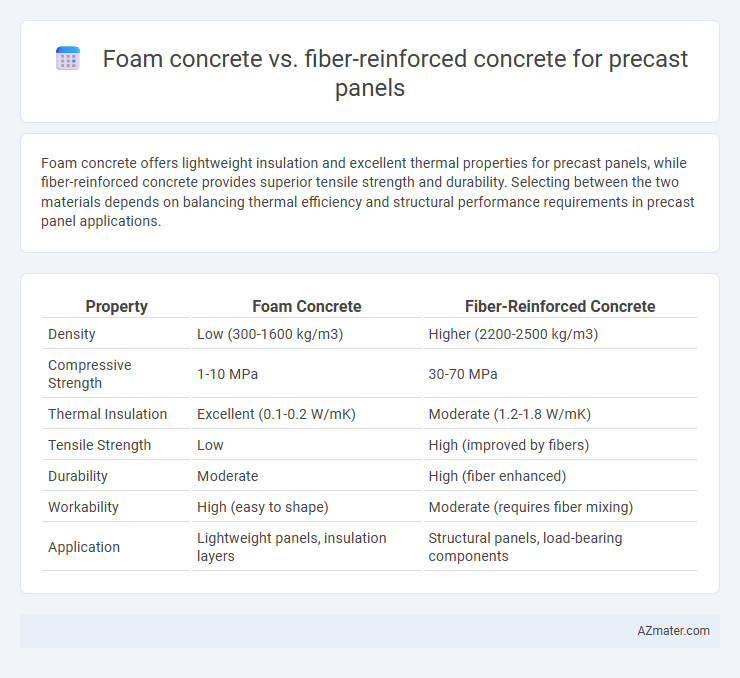Foam concrete offers lightweight insulation and excellent thermal properties for precast panels, while fiber-reinforced concrete provides superior tensile strength and durability. Selecting between the two materials depends on balancing thermal efficiency and structural performance requirements in precast panel applications.
Table of Comparison
| Property | Foam Concrete | Fiber-Reinforced Concrete |
|---|---|---|
| Density | Low (300-1600 kg/m3) | Higher (2200-2500 kg/m3) |
| Compressive Strength | 1-10 MPa | 30-70 MPa |
| Thermal Insulation | Excellent (0.1-0.2 W/mK) | Moderate (1.2-1.8 W/mK) |
| Tensile Strength | Low | High (improved by fibers) |
| Durability | Moderate | High (fiber enhanced) |
| Workability | High (easy to shape) | Moderate (requires fiber mixing) |
| Application | Lightweight panels, insulation layers | Structural panels, load-bearing components |
Introduction to Precast Panels: Material Choices
Precast panels commonly utilize foam concrete and fiber-reinforced concrete as primary material choices, each offering distinct performance characteristics. Foam concrete provides lightweight, thermal insulation, and ease of handling, ideal for non-structural or partition panels. Fiber-reinforced concrete enhances tensile strength, durability, and impact resistance, making it suitable for load-bearing or exterior panels requiring high structural integrity.
Overview of Foam Concrete
Foam concrete is a lightweight, aerated material composed of cement, water, and a stable foam to create a cellular structure that enhances thermal insulation and reduces density. It offers excellent fire resistance, sound absorption, and ease of molding, making it ideal for precast panels requiring energy efficiency and reduced structural load. The material's low compressive strength compared to fiber-reinforced concrete limits its use to non-structural or insulating applications within precast elements.
Overview of Fiber-Reinforced Concrete
Fiber-reinforced concrete (FRC) enhances structural performance of precast panels through the integration of synthetic or steel fibers, which improve tensile strength, crack resistance, and durability. In comparison to foam concrete, FRC offers superior load-bearing capacity and impact resistance, making it ideal for high-strength applications. The fiber distribution within the matrix controls shrinkage and increases flexural toughness, ensuring longer service life in precast construction elements.
Strength and Structural Performance Comparison
Foam concrete exhibits lower compressive strength, typically ranging between 3 to 8 MPa, making it suitable for lightweight, non-load-bearing precast panels, whereas fiber-reinforced concrete (FRC) achieves higher compressive strengths up to 40 MPa with enhanced tensile and flexural performance. The embedded fibers in FRC improve crack resistance and toughness, leading to superior durability and structural integrity under dynamic loads compared to foam concrete. Consequently, fiber-reinforced concrete is preferred for precast panels requiring greater load-bearing capacity and long-term structural performance.
Thermal and Acoustic Insulation Properties
Foam concrete offers superior thermal insulation due to its high air content and lightweight structure, making it ideal for energy-efficient precast panels. Fiber-reinforced concrete enhances acoustic insulation by improving the material's density and reducing sound transmission through effective crack control. Combining these materials can optimize both thermal and acoustic performance in precast panel applications.
Durability and Crack Resistance
Foam concrete offers excellent thermal insulation and lightweight properties but typically exhibits lower tensile strength and crack resistance compared to fiber-reinforced concrete, which incorporates synthetic or steel fibers to significantly enhance durability and minimize cracking in precast panels. Fiber-reinforced concrete's improved crack resistance results in better long-term performance under dynamic loads and environmental stress, making it more suitable for structural precast applications requiring high durability. The enhanced bond strength and toughness of fiber-reinforced concrete contribute to reduced maintenance costs and extended service life of precast panels.
Weight and Handling Differences
Foam concrete offers significantly lower density, typically ranging from 400 to 1600 kg/m3, making it easier to handle and transport for precast panels compared to fiber-reinforced concrete, which generally weighs between 2200 to 2500 kg/m3. The reduced weight of foam concrete panels decreases labor costs and installation time, while fiber-reinforced concrete provides enhanced structural strength and impact resistance at the expense of heaviness. Choosing between the two depends on the balance between weight-sensitive applications and the need for durability and load-bearing capacity in precast panel projects.
Manufacturing and Installation Considerations
Foam concrete offers lightweight properties with excellent thermal insulation and easier on-site handling during precast panel manufacturing, reducing curing time and energy consumption. Fiber-reinforced concrete enhances structural strength and crack resistance in precast panels, but requires careful mixing to ensure even fiber distribution and may increase complexity during casting and finishing processes. Installation of foam concrete panels benefits from reduced weight and quicker fixing, whereas fiber-reinforced concrete panels demand precise handling to maintain fiber alignment and surface integrity.
Cost Analysis: Foam vs Fiber-Reinforced Concrete
Foam concrete offers lower material costs due to its lightweight composition and reduced cement usage, making it an economical choice for precast panels. Fiber-reinforced concrete incurs higher costs primarily from the added synthetic or steel fibers, which improve tensile strength but increase material expenses. Labor and manufacturing processes for foam concrete tend to be simpler, further reducing overall production costs compared to the more complex mixing and handling required for fiber-reinforced variants.
Applications and Recommendations for Precast Panels
Foam concrete offers lightweight and thermal insulation benefits, making it ideal for non-structural precast panels such as partition walls and architectural cladding where reduced weight and energy efficiency are prioritized. Fiber-reinforced concrete enhances tensile strength and crack resistance, suitable for load-bearing precast panels like facades, floor slabs, and structural walls requiring durability and improved mechanical performance. For precast panels demanding both lightweight properties and higher strength, a hybrid approach combining foam concrete with fiber reinforcement provides optimized performance across various construction applications.

Infographic: Foam concrete vs Fiber-reinforced concrete for Precast panel
 azmater.com
azmater.com